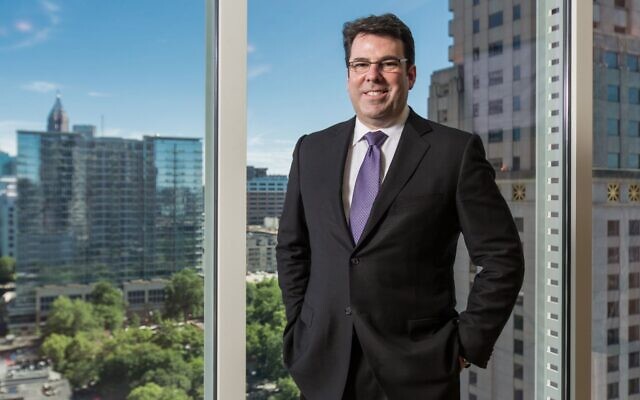The ‘Kvetch’ of an Aching Lower Back
Dr. Reuben Sloan examines causes and treatments for America’s most common pain.
After 37 years with the Atlanta Journal-Constitution and now with the AJT, , Jaffe’s focus is lifestyle, art, dining, fashion, and community events with emphasis on Jewish movers and shakers.

“Oh, my aching back!” The CDC stated in May 2020 that 25 percent of U.S. adults report having experienced lower back pain in the past 90 days. It’s the most common pain reported. Descriptions range from burning sensations to stabbing pains and cost American patients billions in healthcare, lost wages, and decreased productivity. Reuben Sloan, M.D., of Resurgens Orthopaedics, specializes in physical medicine and rehabilitation, non-operative spine care, interventional spinal injections and electrodiagnostic medicine. He told the AJT, “Over the past decade, I have seen an increase in the number of patients presenting with low back pain. The population as a whole is aging, at least in my practice, and I’m seeing an increase in deconditioning, which is directly correlated to an increase in low back pain. This was particularly evident in the past 18 months due to the pandemic.”
Sloan noted that he has not seen an increase in sciatica, which has become the “catch-all phrase for generalized lower back pain, but erroneously so. By definition, sciatica means a nerve irritation involving the lower lumbar roots (L5 and/or S1), resulting in pain in the lower limbs, typically ending in the outer part of the foot or great toe area. Sciatica is just one of many low back ailments. These nerve root(s) can get irritated by a herniated disc or a tight nerve canal (spinal stenosis). Herniated disks tend to be more prevalent in the younger population (under 40 years old), stenosis more prevalent in the older population (65+). As core strength is an essential preventative tool in limiting or eliminating the likelihood of sciatica, it’s far more prevalent in inactive individuals.”
He added, “There is no question that the incidence of low back pain is directly correlated to aging due to natural degeneration of the intervertebral discs and the joints of the low back (facet joints). Low back pain is what I call ‘an equal opportunity offender’ as it tends to affect men as commonly as women, in all races.”
How does one know when to just lay low versus seeking medical treatment?
Sloan: Typically, mild low back pain due to a simple strain or other mild, self-limited cause, will resolve after one or two days of relative rest and over-the-counter (OTC) analgesics, such as Tylenol, or nonsteroidal anti-inflammatory drugs (NSAIDs), such as Aleve or Advil, and don’t require medical attention. If pain lingers, it should be assessed medically. If more concerning symptoms appear, like pain radiating down the leg that’s intensified by lying down or wakes the patient in the middle of the night, get medical attention as soon as possible.
What are the steps to self-care for lower back pain?
Sloan: The best self-care is prevention, and the best prevention is keeping your core fit. By “core” I am referring to the deep abdominal, pelvic and lower back muscles that are typically trained by specific exercises (taught by a physical therapist) or via exercises, and yoga and/or Pilates.
When is surgery the best option?
Sloan: Only when all reasonable conservative measures, including injections (plural) have clearly failed. There are, however, rare situations where surgery is necessary earlier, but that’s another topic. Spine surgery should only be used as a last resort.
Do you find that chiropractic or acupuncture treatments lead to improvement?
Sloan: Improvement? Long-term, no; short-term, yes. Chiropractic treatments are aimed at short-term symptom minimization. If we consider low back pain a “flat tire,” chiropractic treatments put “air in your tire, they don’t fix your flat.” In orthopedics, we put air in your tire with medications and/or injections as we, with the help of our colleagues in the physical therapy world, try to fix your flat with therapeutic exercise instruction. There’s conflicting data on acupuncture, so no one really knows.
What are some new treatments on the horizon?
Sloan: Regenerative medicine (PRP and stem cells) seemed incredibly promising, but unfortunately have yet to be proven effective in clinical trials for the treatment and management of spine conditions, especially low back pain. Hopefully with more time and better designed clinical studies, we’ll have better news.
The best bit of advice for good back health is …
Sloan: Strengthen your core, keep your hamstring muscles flexible. Frequency and consistency are the key. It’s better to stretch twenty times for one minute than one time for twenty minutes!
- Health and Wellness
- Local
- Center for Disease Control and Prevention
- St. Joseph's Hospital
- core strengthening
- muscle flexibility
- Back Pain
- Healthcare
- lost wages
- decreased productivity
- Reuben Sloan M.D.
- Resurgens Orthopaedics
- physical medicine and rehabilitation
- non-operative spine care
- interventional spinal injections
- electrodiagnostic medicine
- Low Back Pain
- pandemic
- sciatica
- Herniated disks
- simple strain
- relative rest
- over-the-counter (OTC) analgesics
- Tylenol
- nonsteroidal anti-inflammatory drugs (NSAIDs)
- Aleve
- Advil
- deep abdominal muscles
- pelvic muscles
- lower back muscles
- exercises
- physical therapist
- yoga
- Pilates
- Spine surgery
- Chiropractic
- acupuncture
- Regenerative medicine (PRP and stem cells)
- Clinical Studies
- Marcia Caller Jaffe



comments